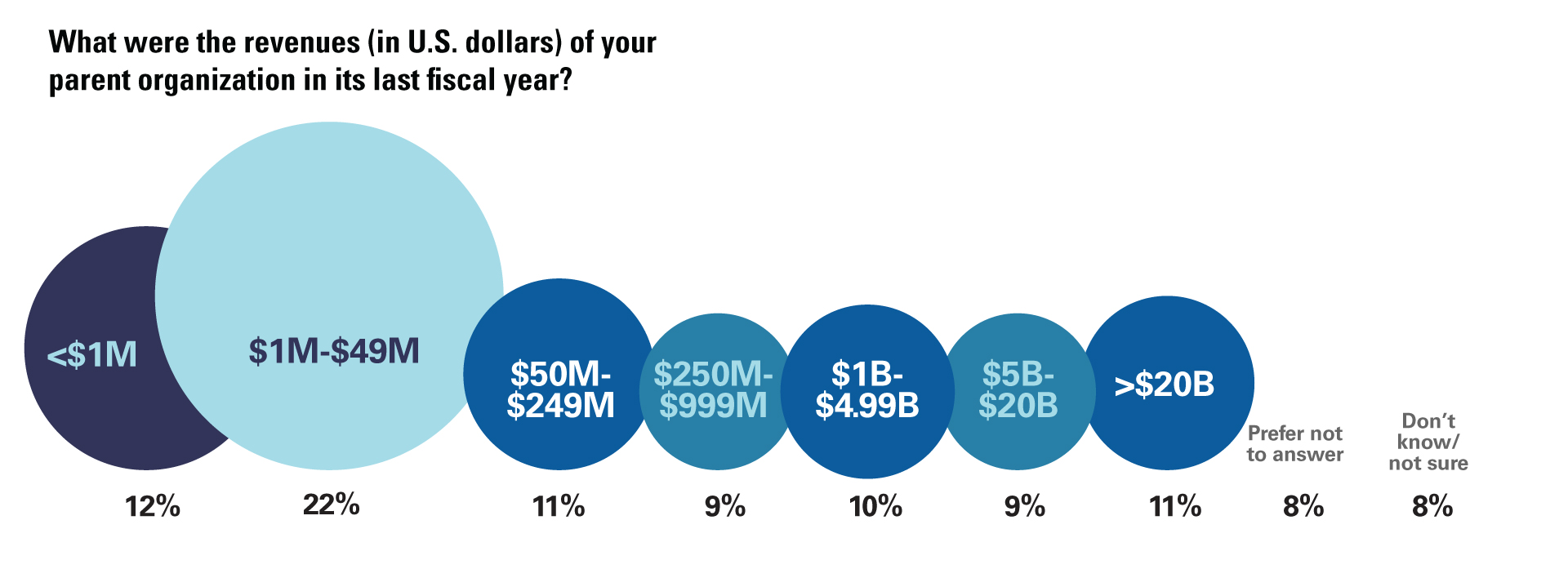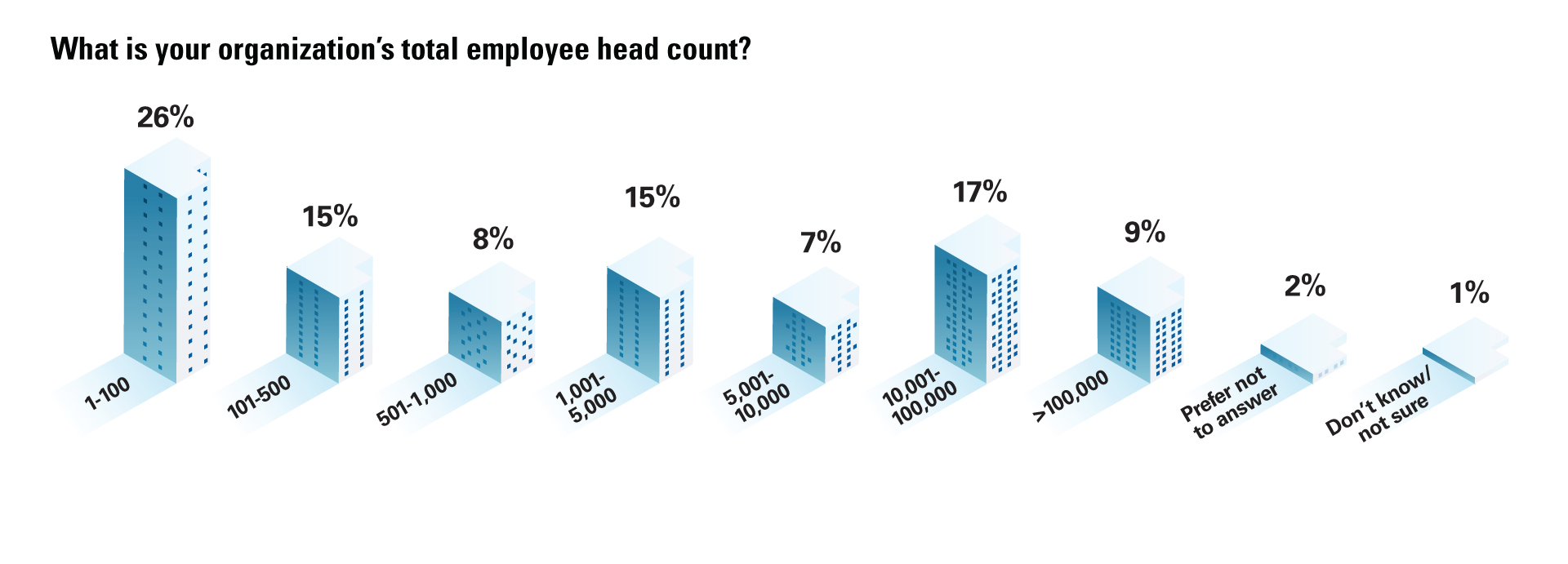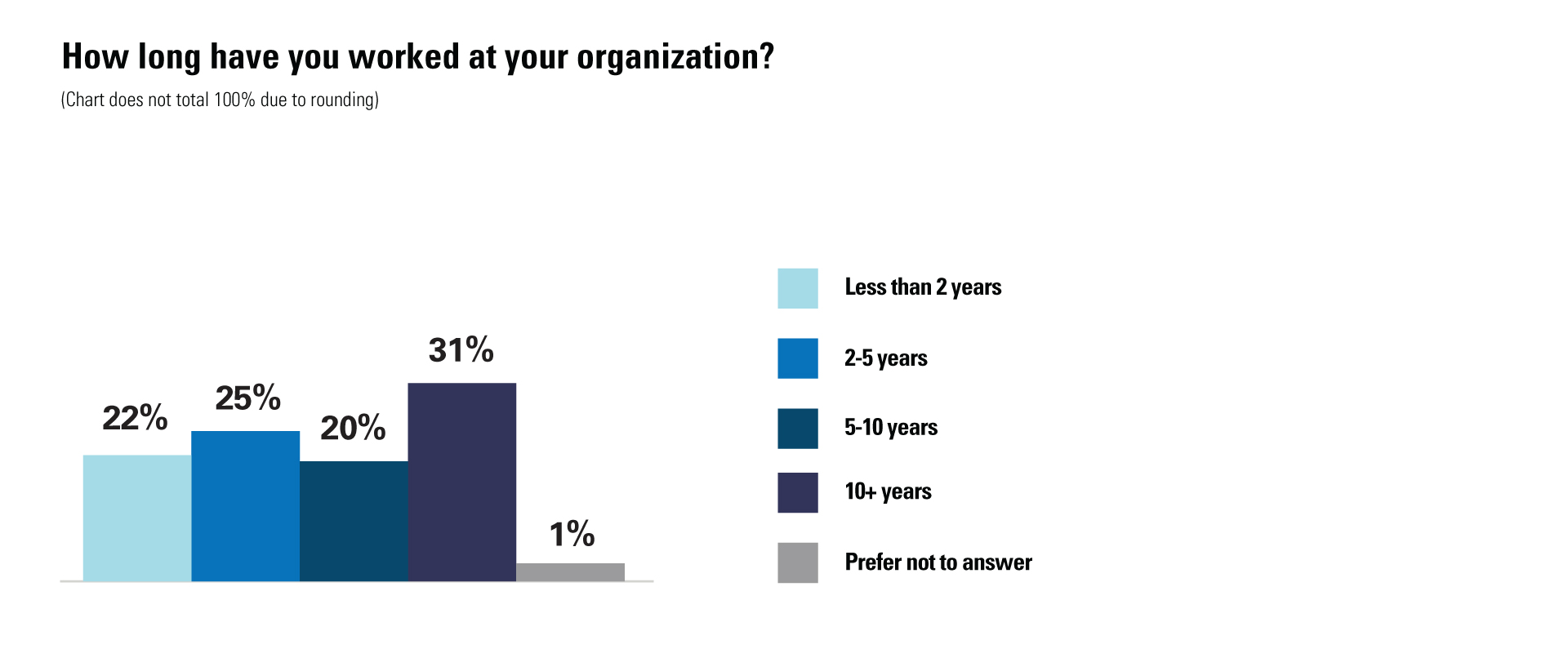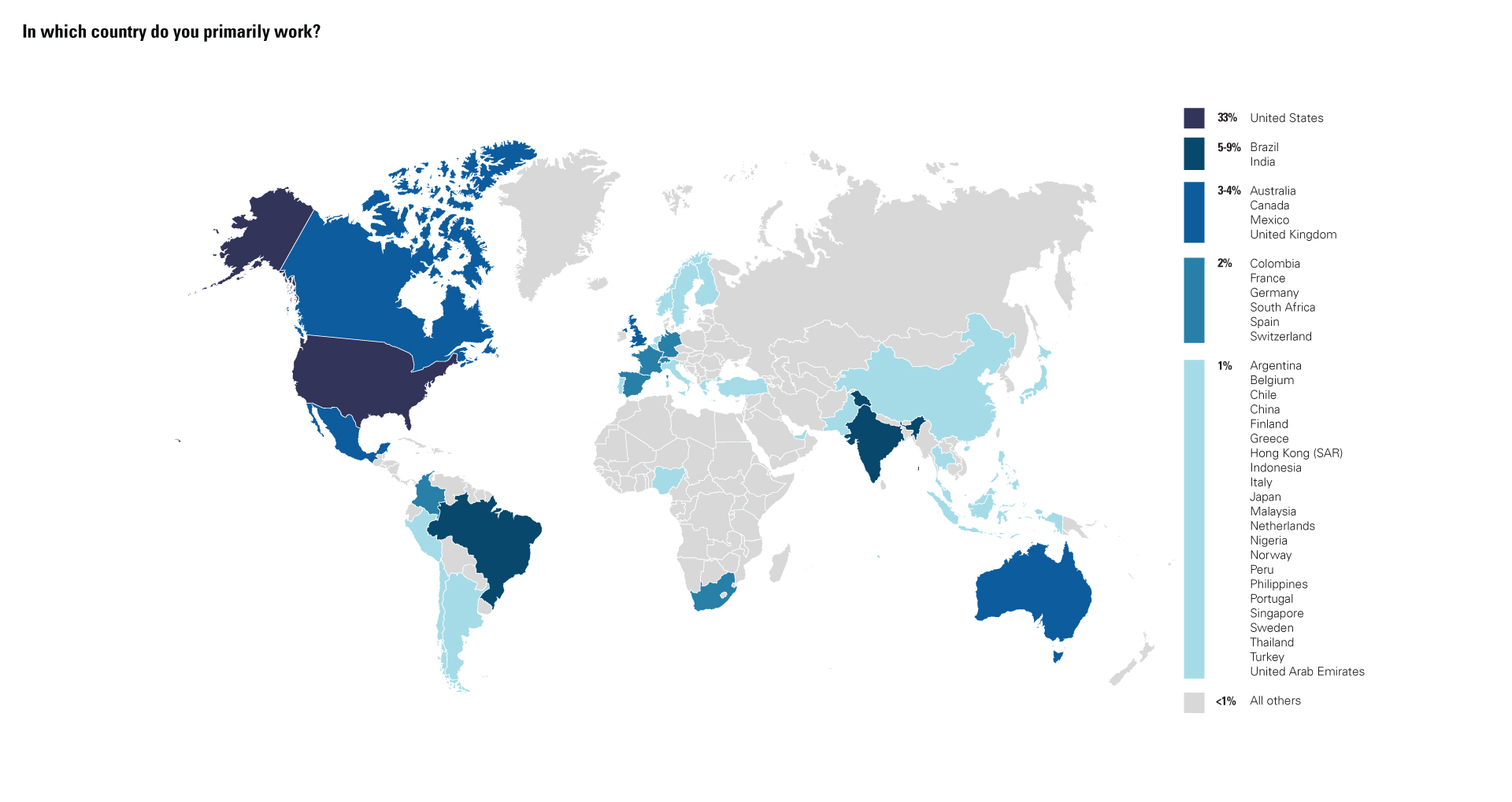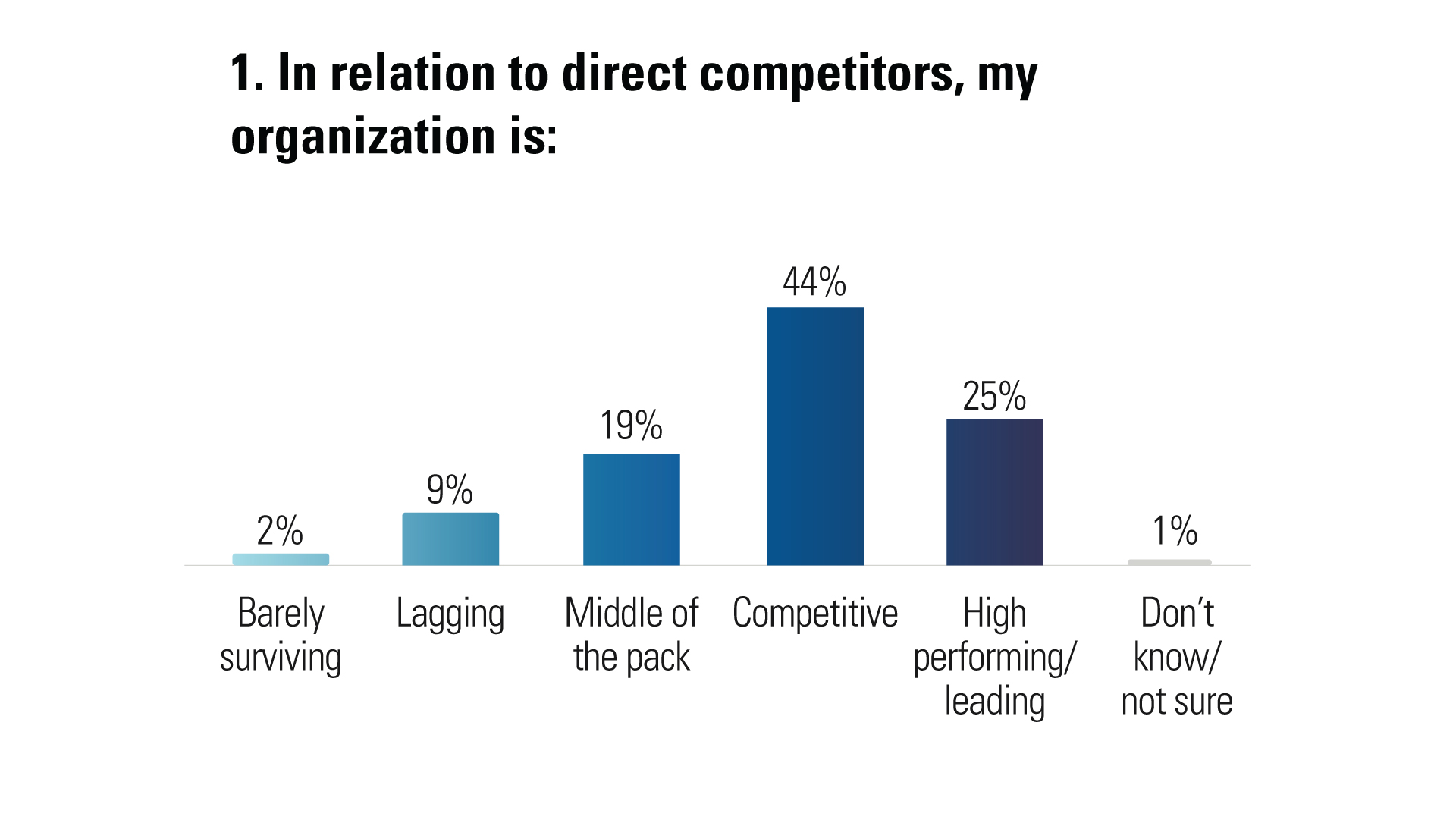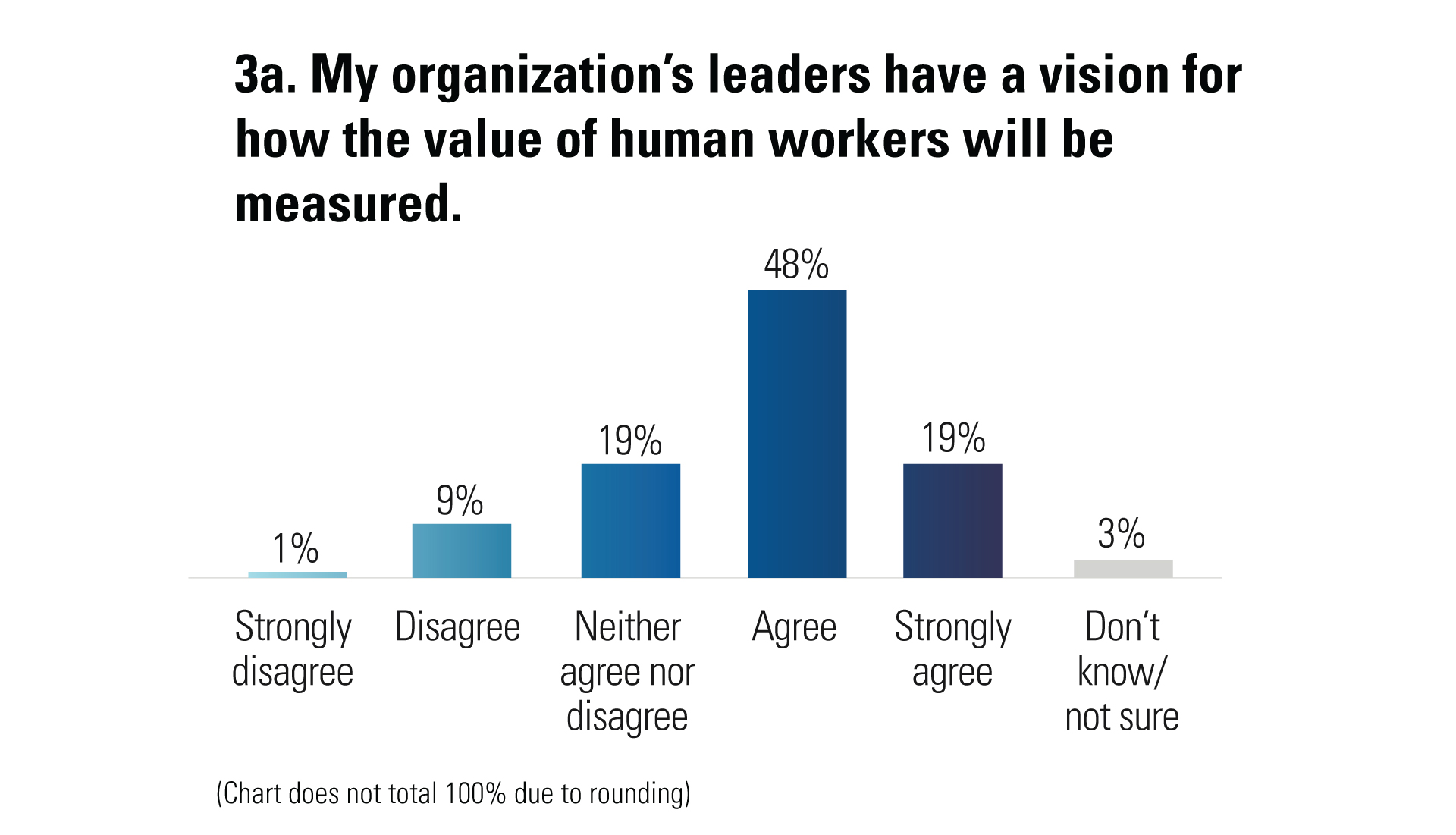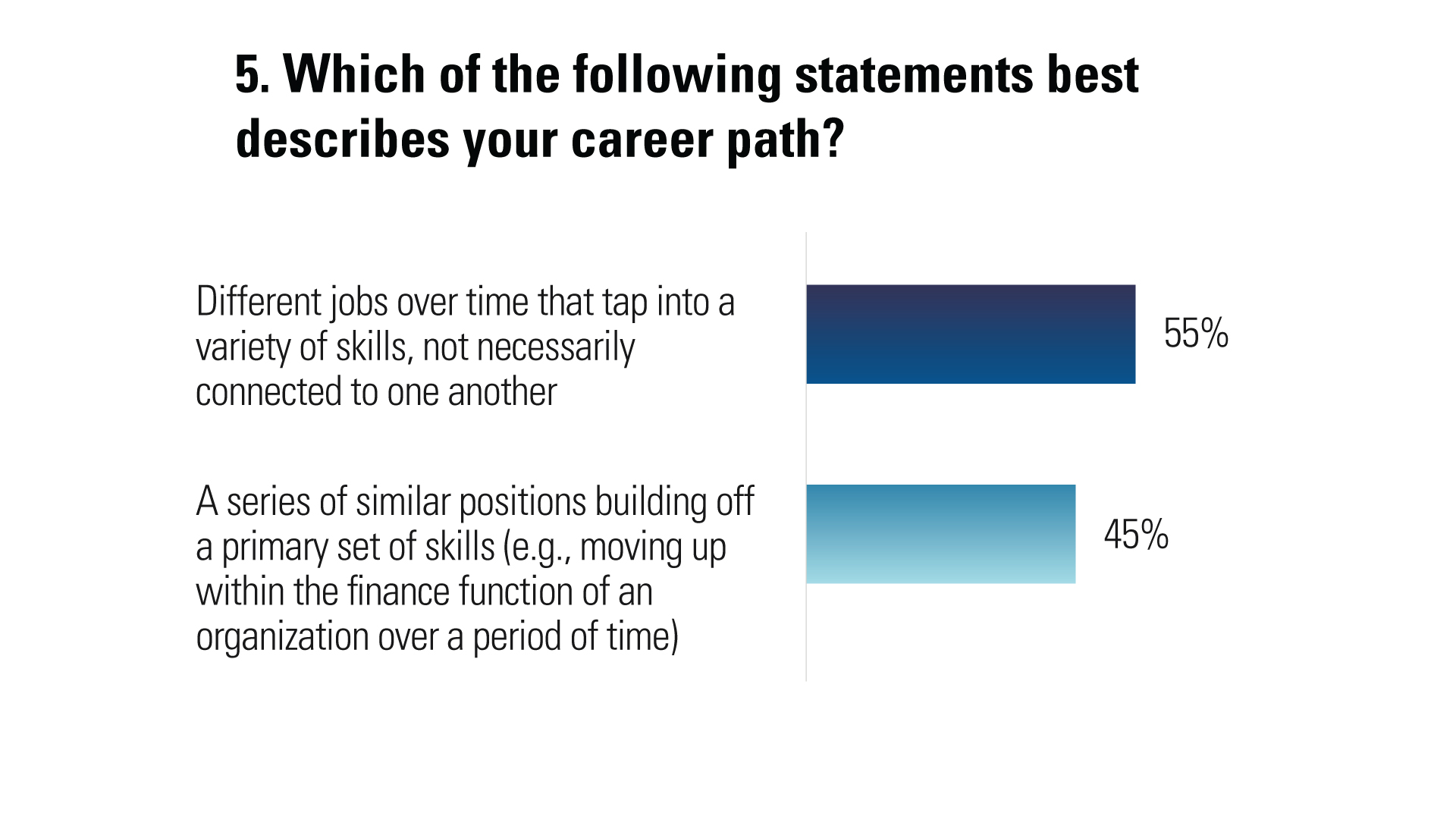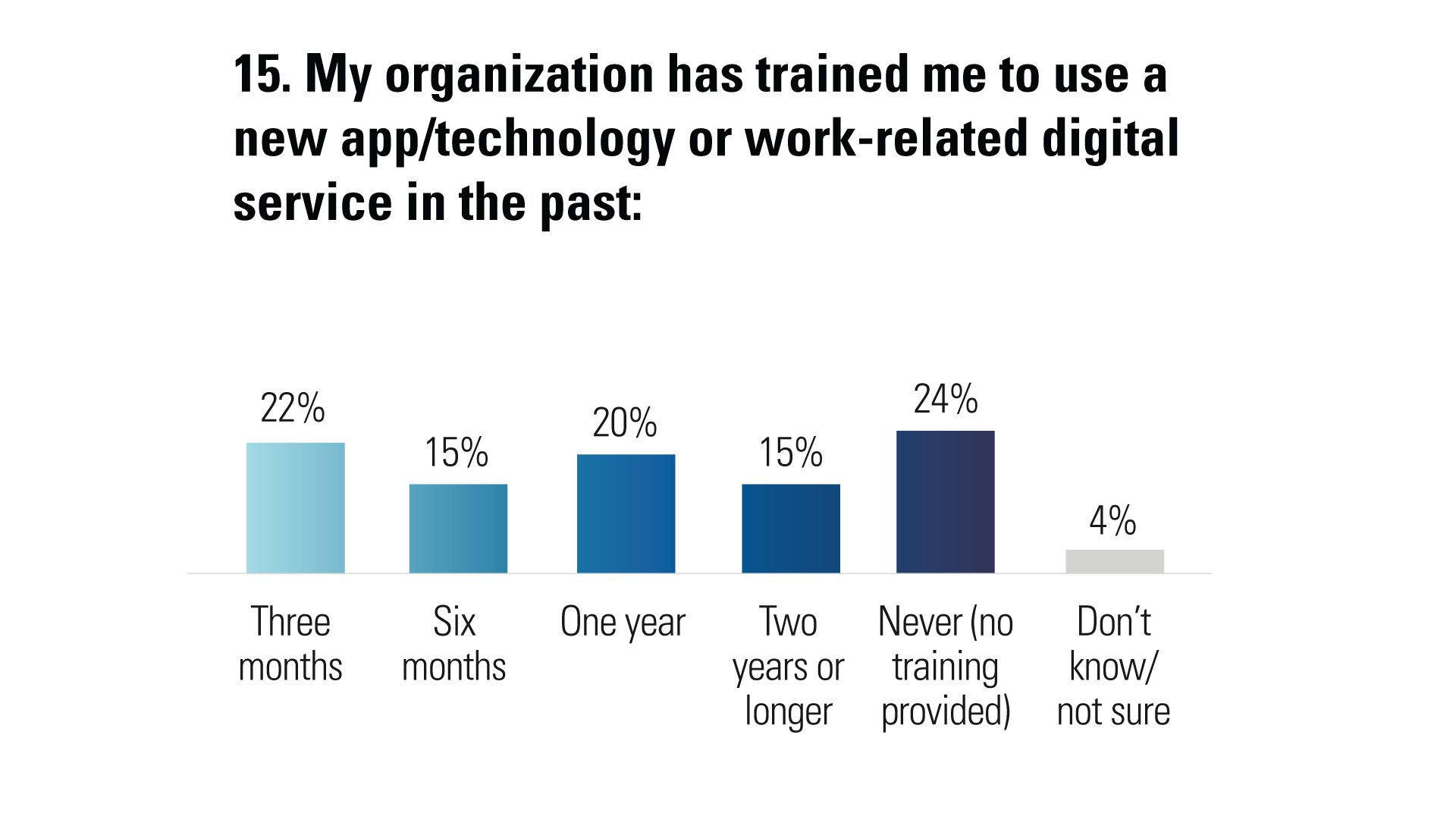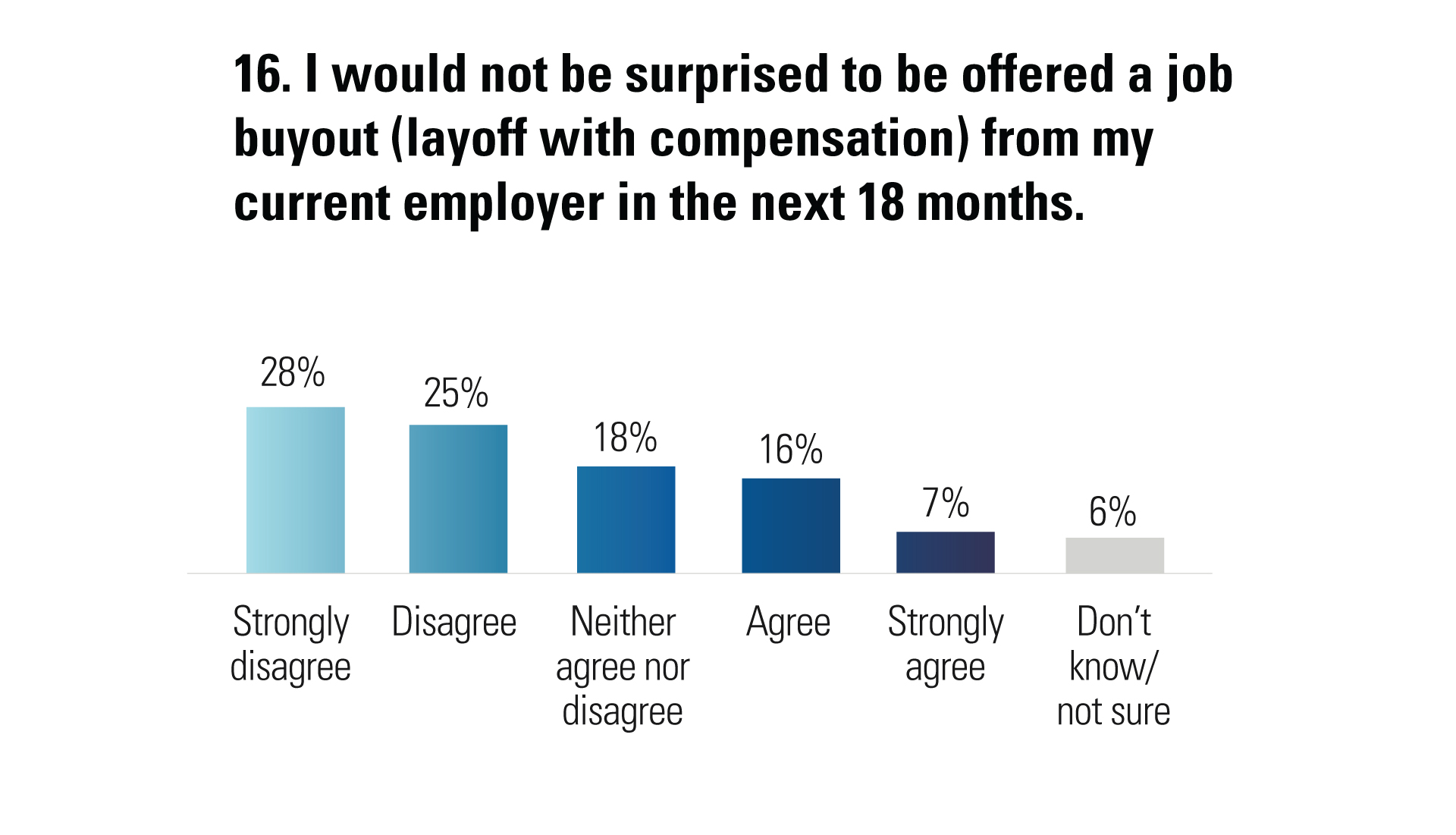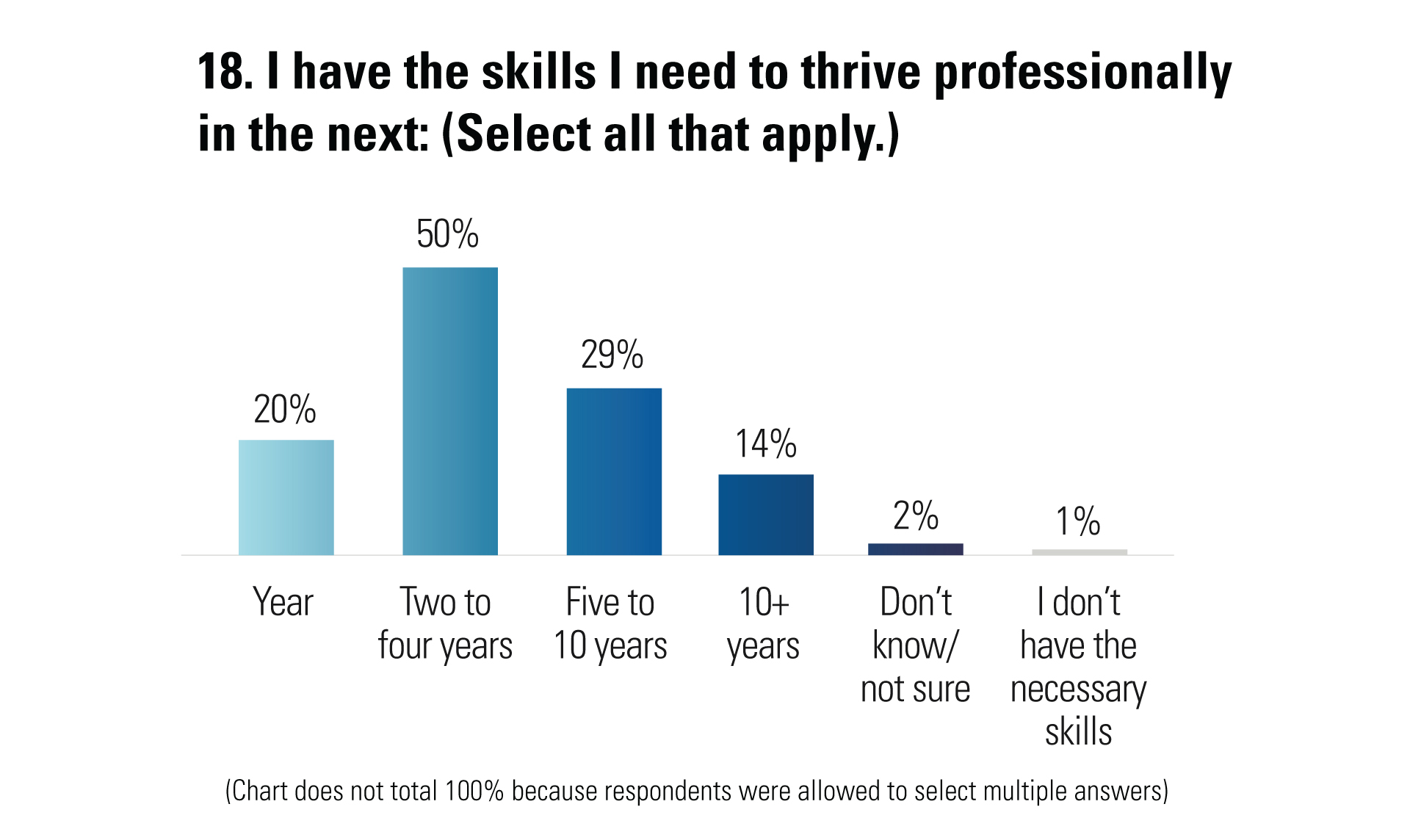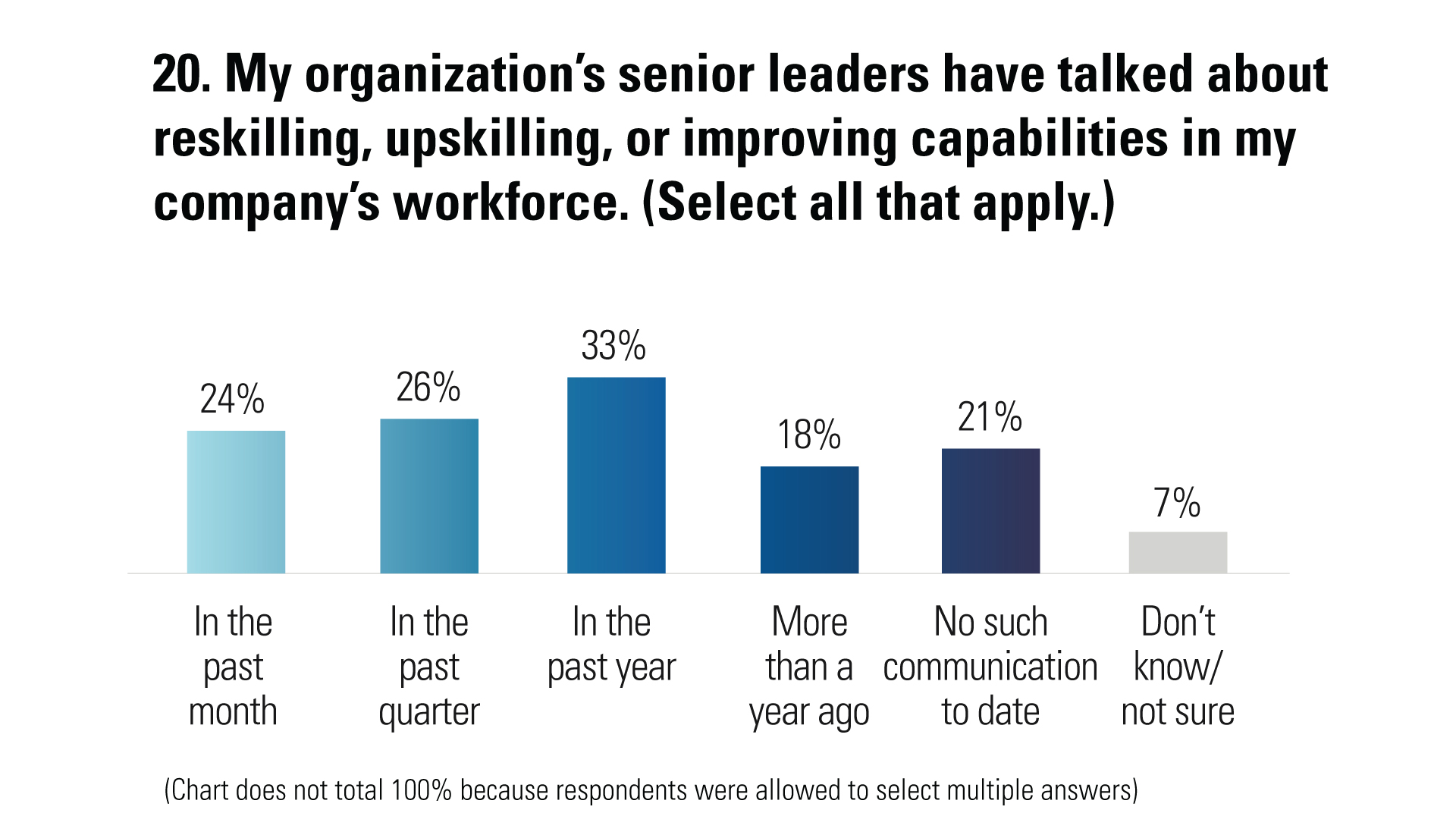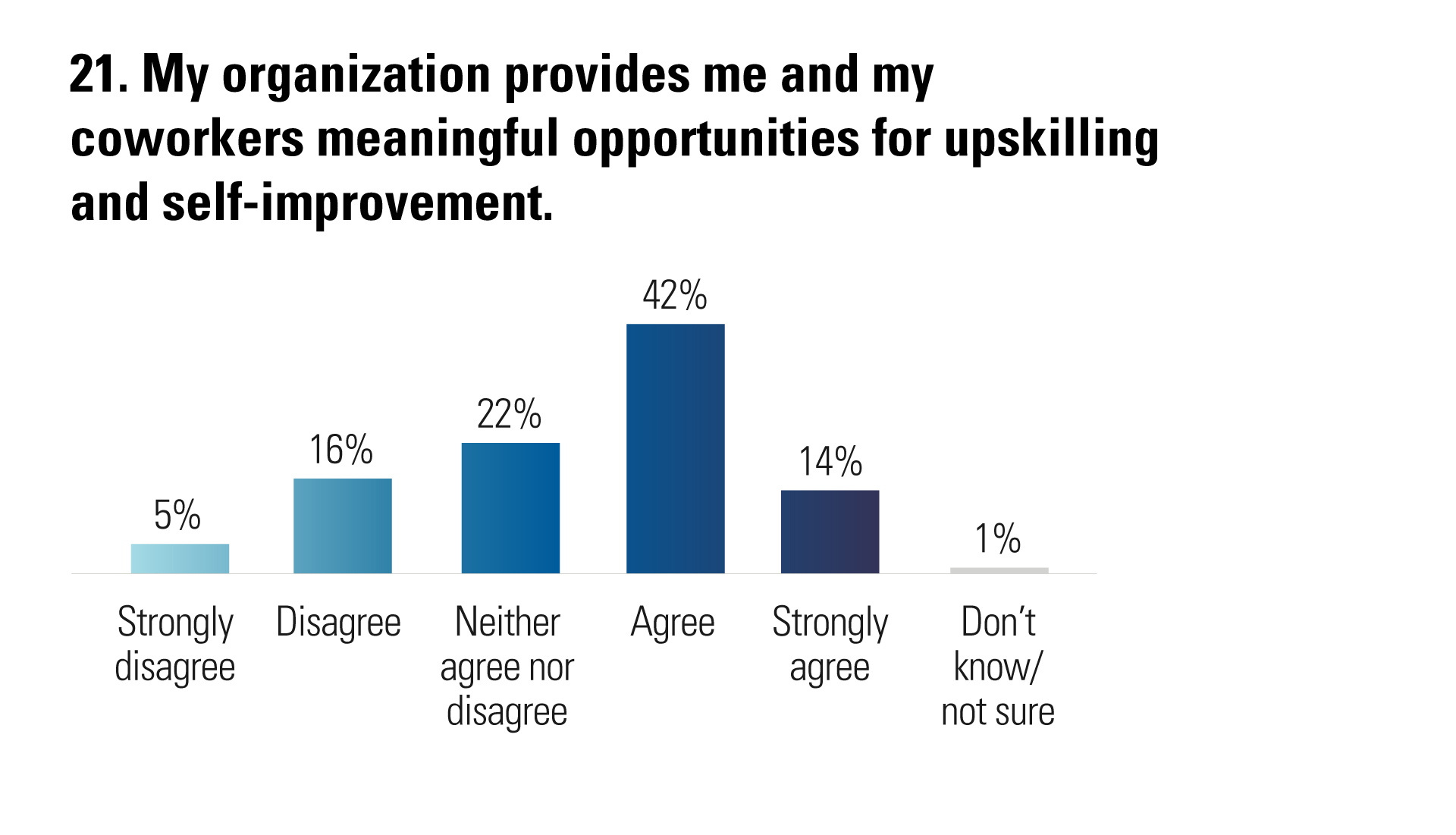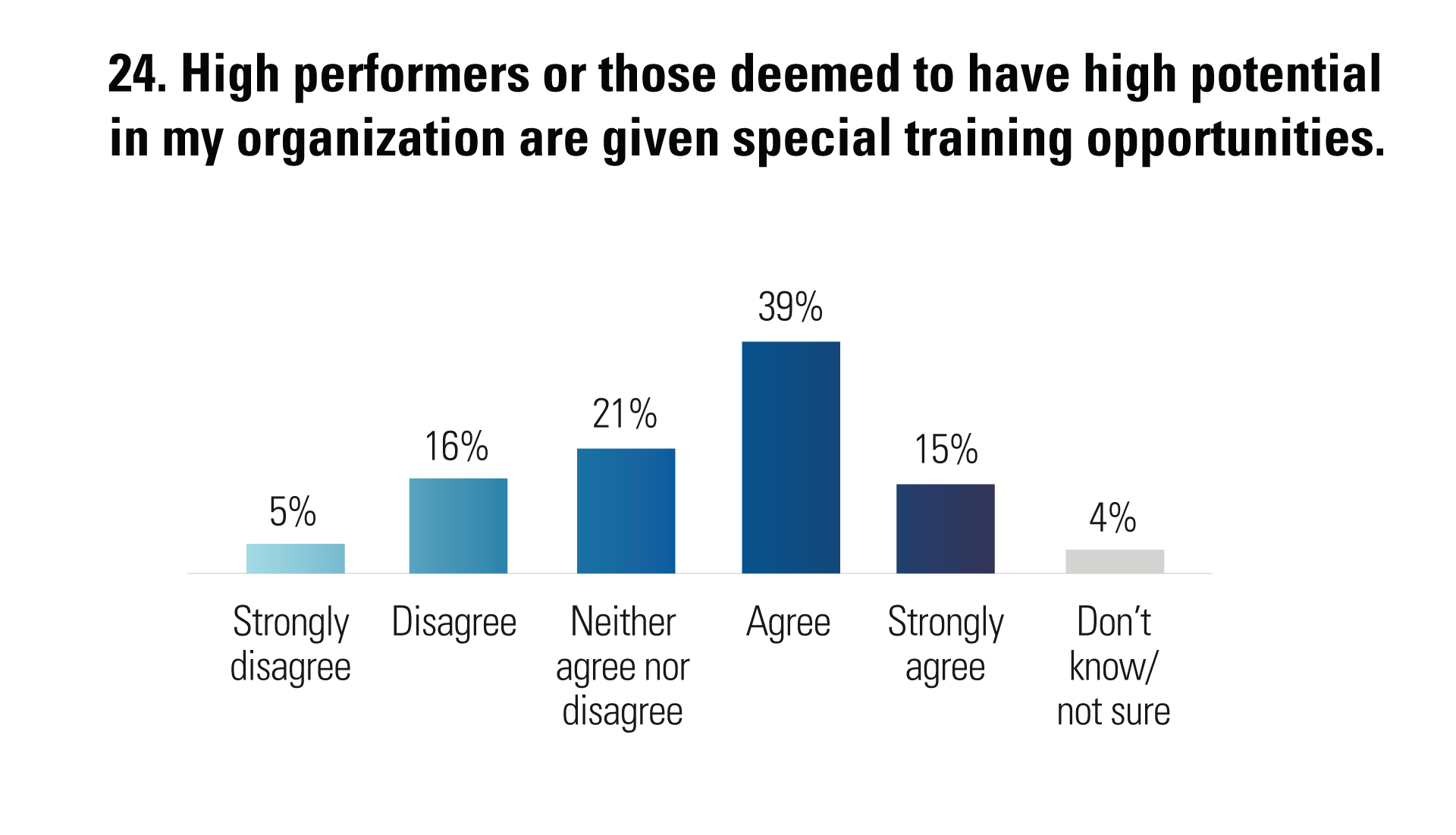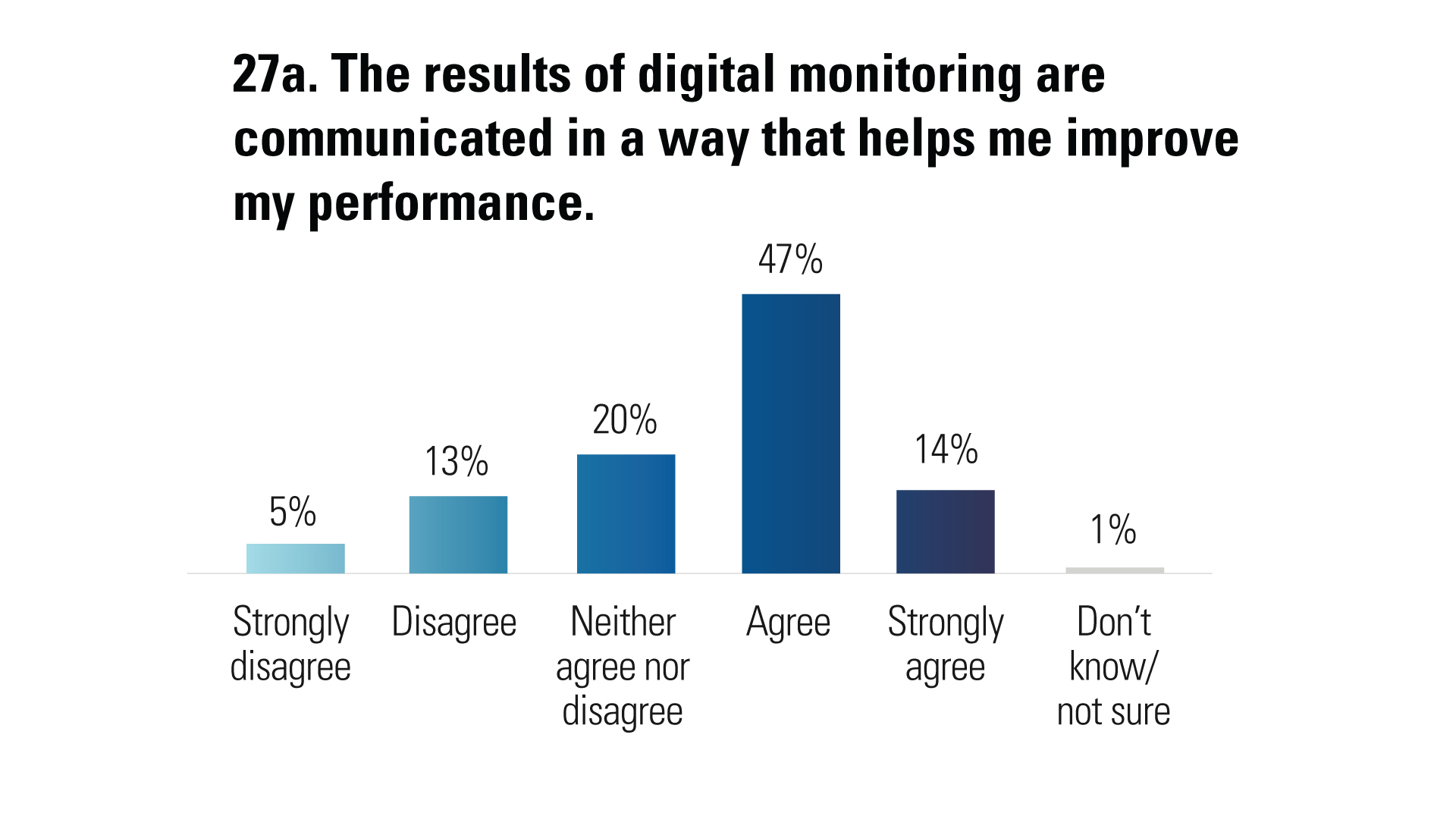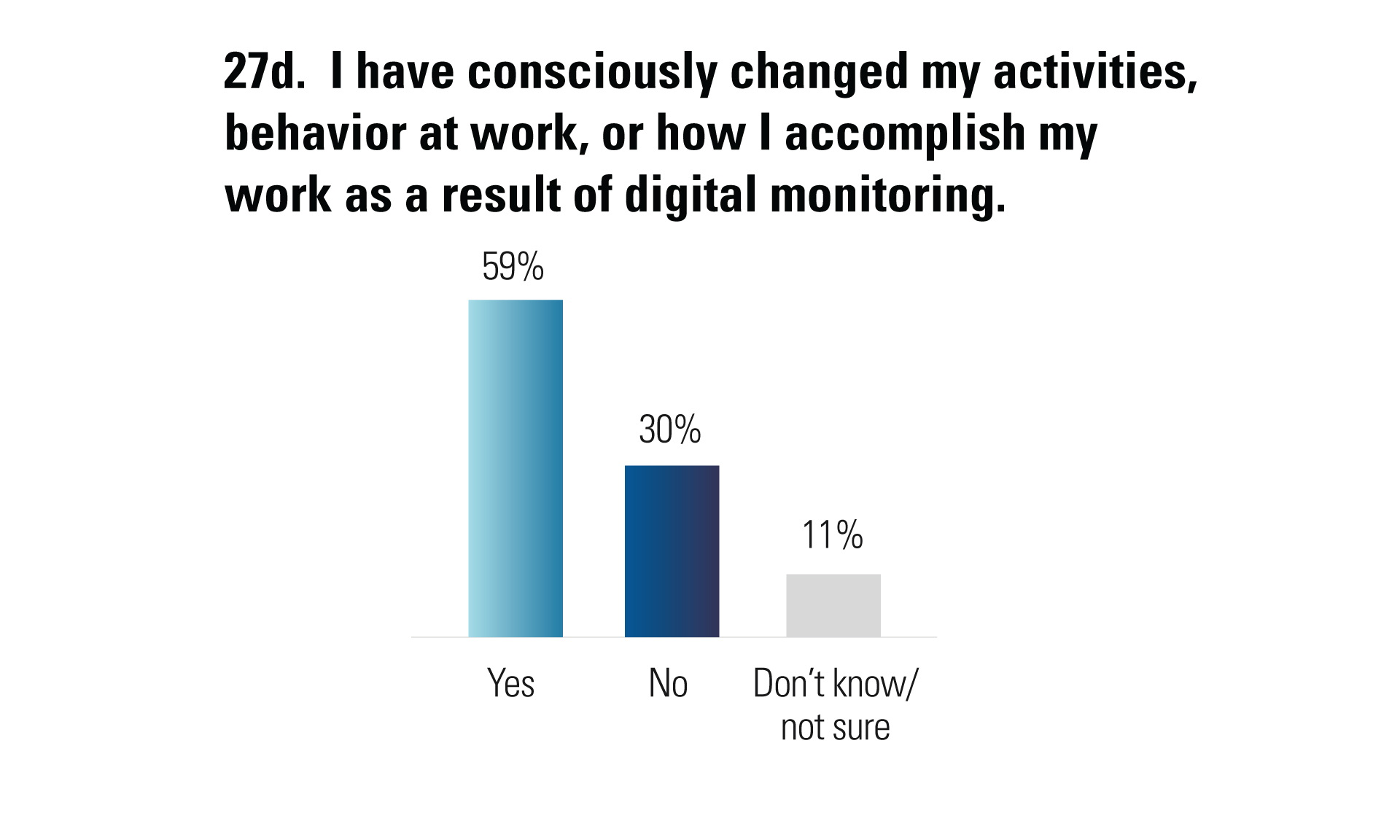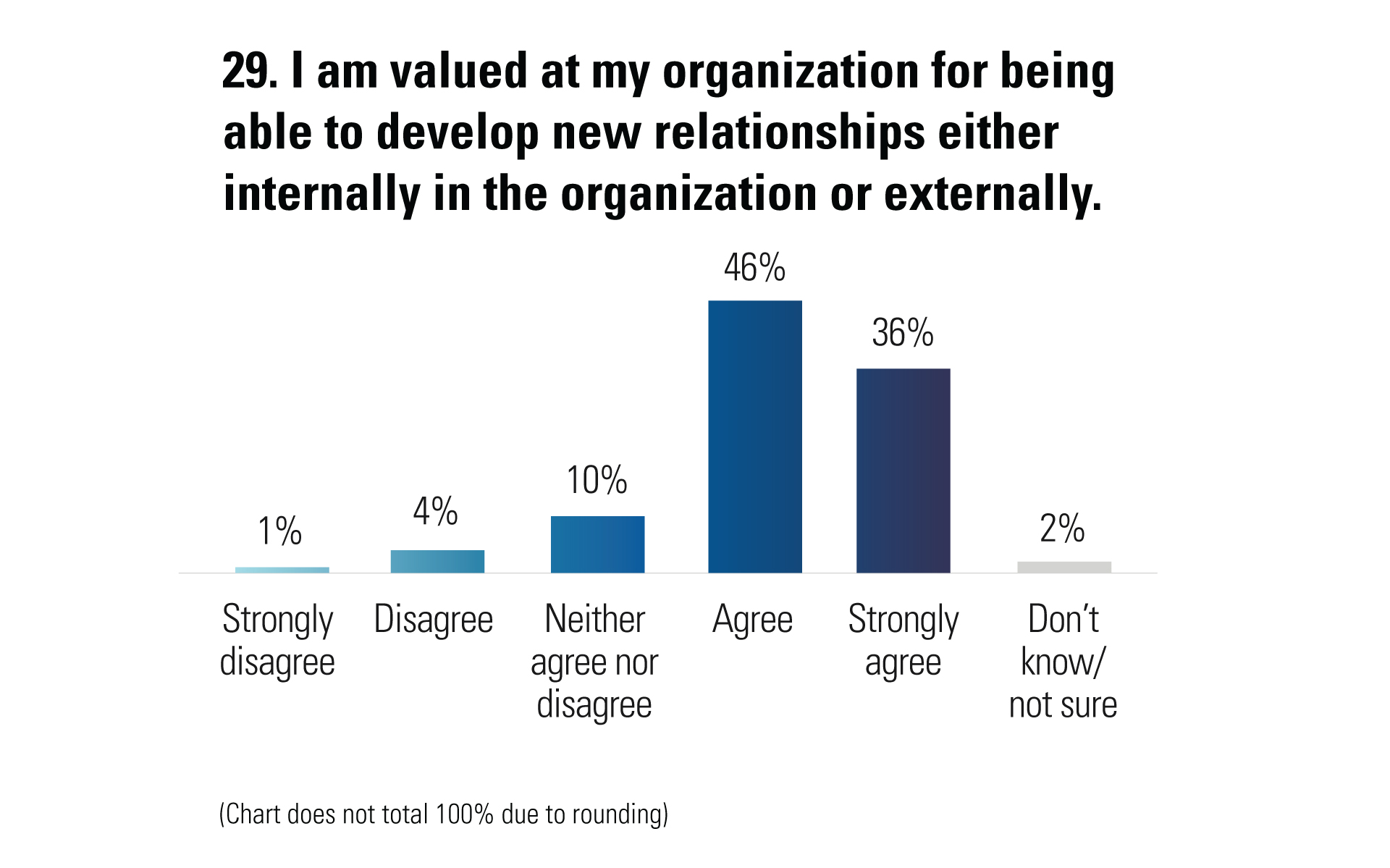Opportunity Marketplaces
Aligning Workforce Investment and Value Creation in the Digital Enterprise
Executive Summary
In response to unrelenting digital disruption, many leaders are rethinking how they value and invest in their workforces. Across the business landscape, corporate leaders are seeking to develop more flexible, adaptive, and valuable workers. Our global research study directly addresses this challenge. Based on a survey of nearly 3,900 respondents and 18 executive interviews, we find that the most effective approaches to achieving a higher-value workforce have a common core: opportunity.
Targeted investment in opportunity is fast becoming the central organizing principle for making more people more valuable in more organizations. Our global executive survey and interviews identify the design of opportunity marketplaces as perhaps the key leadership challenge for most organizations seeking to ethically maximize human capital returns.
We see opportunity marketplaces as systems, digital platforms, and virtual places where organizations provide — and workers find — the opportunities most relevant to their mutual benefit and success. In an effective marketplace, the enterprise offers its workers defined options for professional development, mentorship, project participation, and networking, among others. Empowered workers, in turn, can choose to pursue those opportunities they most value. Vibrant, robust, and inclusive opportunity marketplaces strategically align both individual and enterprise aspirations. Investment in greater workforce opportunity is seen — and understood — as an investment in greater workforce value creation.
In our first year researching the future of the workforce, MIT Sloan Management Review and Deloitte1 present this report highlighting the urgency and importance of this approach. We find that many leaders and workers alike are not satisfied with corporate investments in their development. Seventy-four percent of respondents believe that developing worker skills and capabilities is important to their organization’s strategy, but only 34% are happy with their organization’s investment in them. Nearly half of all workers surveyed are prepared to leave their organization if offered a buyout or severance package.
The corrective, our research shows, goes beyond a greater emphasis on workforce restructuring, retraining, reskilling, and “rightsizing” efforts. For many workers, more skills — and even better experiences — without more opportunity is insufficient. If workers don’t value the opportunities they’re offered — if those opportunities don’t speak to their passion, potential, and purpose, for example — they can and will likely leave. The willingness of many newly developed, higher-skilled talent to walk out the door can intensify the workforce challenge facing many leaders. To escape this trap, leaders should move past mindsets that prioritize controlling costs over empowering people.
One of the most significant research takeaways for top management is that opportunity marketplaces both demand and elicit agency — the perceived ability to influence one’s future — and fundamentally flip a perennial top talent and workforce management question. Where executives once asked, “How can we make better and smarter investments in people?” opportunity marketplaces prompt executives to ask, “How can we support people in making better, smarter investments in themselves?” This flip directly challenges command-and-control leadership styles and may threaten executives who see digital transformation as a platform to strengthen enterprise oversight.
This emphasis on opportunity marketplaces reflects Nobel Prize-winning research on human capital development, behavioral economics, game theory, and market design.2 Our surveyed leaders and organizations assert that, over time, an opportunity marketplace design sensibility best merges ethical and economic imperatives to maximize enterprise productivity and value. The message is clear: One of the surest ways for leaders to create better opportunities for their organizations is to create better opportunities for their people.

Schneider Electric Creates an Opportunity Marketplace
Schneider Electric’s Andrew Saidy is well aware that most people don’t understand his job title. The vice president of talent digitization at the global energy management company explains his role this way: “I help generate revenues by launching technologies that ensure our employees work more efficiently, they remain with Schneider, and their engagement levels go up.”
The French multinational, founded in 1836 as Schneider & Cie, employs a 135,000-person workforce and has a presence in more than 100 countries (with more employees in the United States than anywhere else). It’s a legacy company, but it was compelled to disrupt legacy personnel practices when analytics revealed that nearly half the employees who left the organization did so because they felt they had no sufficient visibility to future growth opportunities.
At Schneider, the hard- and soft-dollar costs of attrition led the company, in 2018, to launch its “open talent market,” which uses AI to match employees with short-term projects, stretch assignments, side gigs, full-time roles, and mentors. As Schneider HR vice president Amy deCastro explains, “We are creating an internal market that wasn’t there before, and it’s a market that employees can take advantage of instead of going out into the external market.”
Analytics drive the opportunity offerings in Schneider’s internal market, an AI-powered platform created by HR tech startup Gloat. This opportunity marketplace in turn generates a wealth of data for Schneider about its employees’ skills and interests, ensuring explicit and measurable alignment between internal opportunities and Schneider’s broader strategic aspirations. It also primes employees to fulfill the priority of better meeting and exceeding client expectations.
Importantly, the platform’s analytics aren’t used to dictate career paths but to enable agency and choice: Employees are expected to take the initiative. “We’ve always told our employees that they own their careers, that they are in the driver’s seat,” Saidy says. With its opportunity marketplace, Schneider’s workplace culture has become more dynamic and responsive so that employees find it easier to invest in themselves. This commitment goes beyond retraining and upskilling: Schneider’s opportunity market can guide talent to projects aligned with their own sense of purpose and goals.
Empowering workers is consistent with the company’s culture and values. Saidy and deCastro stress that Schneider sees each employee not as just a means to profit but as a whole person. Saidy characterizes Schneider as having a “kind” culture and emphasizes that his role goes beyond generating measurable ROI. “We really do look at the whole person when they’re employed with Schneider,” deCastro says. The company uses digital safeguards to make sure, for instance, that side gigs and stretch assignments don’t overwhelm employees, in addition to piloting new features that alert employees if they consistently start their days too early or send too many work-related emails after hours.
HR has been a close and integral partner throughout this digital transformation process. According to Saidy, HR is “not a compliance function” but rather a “strategic partner in disruption” under chief HR officer Olivier Blum, who held prominent executive roles in sales and marketing at Schneider before moving to the department.
“If you’re doing your day-to-day job and you’re not doing anything else, you’re not acquiring new experiences. Our purpose is to create new opportunities for employees to acquire new experiences and skills.”
–Andrew Saidy, vice president, talent digitization, Schneider Electric
Although precise data is not yet available, Saidy says attrition has decreased in areas where the opportunity market has been launched. A vice president of talent digitization might indeed be an unusual organizational role, but when “talent digitization” represents a strategic investment in human capital, it has a compelling rationale. Saidy sees that rationale this way: “If you’re doing your day-to-day job and you’re not doing anything else, you’re not acquiring new experiences. Our purpose is to create new opportunities for employees to acquire new experiences and skills.”
With data from a global survey of nearly 3,900 respondents and interviews with 18 executives and thought leaders, this report argues that top management must define a new value vocabulary around the future of workforce opportunity. The popular and public-policy emphasis on upskilling, reskilling, and training appears to be inadequate. The more productive framing is on opportunity marketplaces that regard workers as both economic assets and whole persons.
Our suggested framework redefines and redesigns internal opportunities for personal and professional development. It can help leaders assess whether their enterprises have the mindset and the mechanisms to create sufficient opportunities for their workforces. The opportunities should empower employees to meaningfully and measurably invest in themselves in ways that generate value for the organization.
This opportunity-centered approach may well prove to be the most ethical and economical way to align enterprise values with enterprise value creation. Schneider Electric offers but one case study of how data- and analytics-driven investments in opportunity marketplaces can make both employees and their employers more productive and more valuable. As we will see, there are others as novel and compelling.

Workers and Management, Disconnected and Misaligned
Organizations have made great progress in developing digital strategies leveraging social, mobile, and cloud. Explosive growth in AI, data, and analytics, however, is driving a new round of digital business disruption. These disruptions often demand new approaches to managing, empowering, and aligning workers to desired strategic outcomes. Yet there is no clear or emerging consensus — no best practice that a majority of managers embrace.
Our research reveals that to a striking degree, many workers are dissatisfied with their organizations’ investments in their professional development. Many feel undervalued as assets and as potential contributors to future value creation. These findings suggest a serious misalignment between the workforce and organizational strategy.
The Workers’ View
According to our global survey, many workers feel disconnected and dissatisfied. A majority of those we surveyed, including executives, perceive a lack of investment in their development.
- Seventy-four percent of respondents believe that the development of new skills and capabilities is strategically important in their organization, but less than one-third (32%) say they are rewarded for developing new skills. (See Figure 1.)
- Less than half of respondents (47%) think that their company is making a significant investment in their professional development, and only 34% are happy with their organization’s investment in improving their skills and performance.
- Executives are dissatisfied as well: Less than 40% of executives are happy with their organization’s investment in their development. (See Figure 2.)
Given these findings, it is unsurprising that many workers feel detached from their organizations and that many believe their skills would be better appreciated elsewhere. Forty-five percent of respondents would like to receive an employee buyout (a voluntary severance package) or are neutral on the question. More than twice as many respondents say it is easier to get a new job outside their organization (40%) than within it (17%). (See Figure 3.)
Given their perceptions of underinvestment, it’s intriguing that a strong majority of respondents (84%) maintain that they continue to learn valuable skills and have valuable experiences in their current job. A similarly strong majority (82%) are confident in their ability to get another job inside or outside their organization based on the skills and experience they’re gaining from their current position. We infer that they enjoy this confidence in spite of — not because of — their employers. Less than half of respondents (41%) recognize that they have the skills they need to thrive professionally for a maximum of four years. (See Figure 4.)
These contradictory responses raise the question of whether the broad dissatisfaction surfaced by our survey is rooted in perception or in reality. Different organizations obviously have different values when it comes to employee development: Some perceive investment in employees in primarily economic and transactional terms, while others balance economic factors with ethical and cultural considerations. Still others haven’t given the question much deliberate thought at all. Several of our interviewees, however, have observed general patterns in how top management views the workforce. Their observations affirm our respondents’ general view that organizations are taking transactional and cost-efficiency approaches to workforce management.
Thomas Kochan’s perspective validates those respondents who feel that their workplaces aren’t interested in their long-term development. “Executives don’t see the full value of investing in the workforce for the long run,” says Kochan, codirector of MIT Sloan School of Management’s Institute for Work and Employment Research. He describes that investment as “being able to drive productivity improvements by having good jobs that pay good wages and having workers who are well trained ahead of any investments in technology, so that they can add value to the process of both designing and implementing the technology and then continuing that innovation process.” He continues, “Labor is still too often viewed as a cost.”
“Labor is still too often viewed as a cost.”
–Thomas Kochan, codirector, Institute for Work and Employment Research, MIT Sloan School of Management
Oren Cass, author of The Once and Future Worker and executive director of American Compass, makes a related point. “The business community takes it for granted that labor is just an input like any other and that, as they design their business models and processes and practices, they are entitled to assume there is a market that will supply to them whatever labor they want, just like they can count on the market to supply to them whatever services and widgets and other things they might want,” Cass says. “I think that is both economically and practically wrong and philosophically and socially wrong.”
One leader at an HR software company extends this idea even further, describing a prevailing organizational mindset that evokes a decidedly mechanistic view of the workforce.
“What no one says but is a banner headline for everyone’s place is, ‘We hate individuals. We love conformity.’ All of the recruiting models and the performance management models are tilting against the annoying messiness of human uniqueness. It’s all, ‘I wish you weren’t like you. I wish you were like a model that we’ve recruited for and built our AI machine learning algorithms to optimize for.’ It’s all designed to say, ‘You are a mess, and I need to clean you up, align you, fit you to a model.’ The whole design principle of work tilts against the thing about a person that the person feels is special. That’s weird.”
– HR software company leader

Opportunity Corrects the Disconnect
Leading enterprises take deliberate steps to invest in and transform their workforces in ways that are mutually beneficial. They invest not just in retraining or upskilling workers but in providing opportunities for professional development and achievement. Our quantitative and qualitative data suggests that these organizations don’t just see workers as an operational means to an end but as assets worth cultivating. Top management at these companies seems to ensure that their strategic vision and priorities are reflected and embedded in opportunities.
Opportunity-centric approaches represent a conscious shift away from transactional commitments. They signal more employee-centered approaches to value creation. Moreover, they don’t require workers to leave their whole selves behind when they walk through the office door. Our survey results suggest that workers whose organizations are investing in them in these ways are more satisfied with their jobs. Respondents from these companies are also more likely to report their organization outperforms its peers. (See Figure 5 and “About the Research.”)
A deeper data dive uncovers a complex link between employee investment, job satisfaction, and organizational performance. Leadership vision, communication, and action can significantly contribute to both worker satisfaction and organizational performance. The importance of “tone at the top” — with senior executives explicitly supporting the virtues and value of opportunity — cannot be overemphasized. A cluster analysis of our survey data shows that Promoters, those respondents most satisfied with their organization’s investment in their professional development, feel more attached to their organizations and more supported by a leadership vision for how employees will contribute value.
85% of Promoters agree or strongly agree that their leaders have a vision for how employees will contribute value in the next five years, versus 38% of Detractors.
Leaders at Promoters’ companies not only more frequently discuss capability improvement than leaders at other companies but are far more likely to offer opportunities to further build worker capabilities. These findings are not primarily a function of Promoters being high performers; the majority of both Promoters and Detractors (those respondents least satisfied with their organization’s investment in their professional development) describe themselves as high performers.
• Promoters are more than 3x as likely as Detractors to work in organizations where leaders have discussed improving capabilities in the past month.
• 61% of Promoters have been trained on using a new technology or digital service in the past six months, compared with 18% of Detractors.
There is also a clear difference between Promoters’ and Detractors’ perceptions of internal opportunity. Compared with Detractors, more than twice as many Promoters (69% versus 32%) agree that it’s just as easy or easier to get a job inside their organization as outside it. More than half of Detractors say it’s easier to get a job outside their organization. Opportunity shortfalls tend to invite low morale, low productivity, and attrition.
Looking Through the Opportunity Lens
Meeting an enterprise’s need for new skills is different and distinct from enabling opportunities for workers to have new experiences and learn from them, develop and apply valued skills, and move seamlessly and friction-free to new roles in the organization. Executives we spoke with consistently asserted that they felt the best way to accomplish the former was by committing to the latter. They emphasize the importance of providing opportunities so that workers can develop in ways that both they and the company value.
Schneider Electric, for example, maintains a continually updated system of reference that catalogs the skills necessary for each job organizationwide. The company also methodically seeks input from employees about which skills they’re most interested in acquiring. “Available analytics could tell us what skills are in demand, what skills employees want to learn, and what skills are the ones that are withering away and not being used anymore,” Schneider’s Saidy says. The workforce opportunities Schneider offers will be increasingly informed by that data.
A payroll company we spoke with explicitly and systematically offers new opportunities to workers as a way to better create value for individuals and the organization. “The No. 1 thing that we’re doing is cultivating a mutual dependency, making sure that we are putting them in a position where they are able to stay on that technological cutting edge,” says one executive. “If we don’t, our people will leave. They recognize, more so than ever before, they’re investing in themselves. And I believe they are taking more control and more accountability for their own development.”
HR software and services company Ceridian also values mobility and development, but chief people and culture officer Lisa Sterling notes that employees must accept greater responsibility for their careers and take the initiative to invest in them. “We have to provide opportunities for people to be invested in,” she says, “but people have to take the initiative themselves to seek out and prove their worthiness for that investment.”
That’s agency. If workers believe that opportunities are genuine, valuable, trustworthy, and accessible, they will likely feel empowered to pursue them. Psychological safety is critical for workers to both perceive and take advantage of opportunities.3 According to Nobel laureate Amartya Sen, agency is essential to human flourishing and depends on the ability to achieve goals that one has reason to value.4 Effective strategies for reskilling, retention, and mobility reconcile the values of leaders and their workers.
Our research highlights three key factors that can enable opportunity-centric enterprise success:
- A clear leadership vision for how the human workforce will create value.
- A cultural shift recognizing and rewarding individual initiative and agency.
- Access to tools and resources to boost competencies, self-investment, and shared development interests.
Leadership Commitment to Building Opportunity
Leadership is crucial to ensuring a healthy flow of talent across an enterprise, says Ceridian’s Sterling. In the past, some leaders at Ceridian were reluctant to encourage workers to take their skills to other parts of the organization. Now, she says, leaders understand that “we actually drive greater productivity from people in their current roles when they can do other things that they’re passionate about and excel at.” Exercising agency around opportunity can unlock economic value and human potential.
At Henry Ford Health System, Sarah Sheffer, director of strategic workforce planning, has a directive to help leaders “start to think not just, ‘Somebody has left; I have an open seat and need this position filled ASAP,’ but rather, ‘How can we start thinking about skills of the future? What will this person’s job look like in the next year or two years or three years?’ It’s a leadership mindset that needs to shift.”
Marriott International, the multinational hospitality company, discovered that leadership by example matters enormously. Workers are more likely to take advantage of learning opportunities when their leaders take training themselves. At properties where the general manager (GM) completed a particular training curriculum on the company’s new just-in-time Digital Learning Platform, observes global HR officer — talent development and organizational capability & global development Ty Breland, over 80% of staff followed suit. When the GM failed to complete the training, in contrast, less than a third of staff typically completed it.
More significantly, the properties where GMs and staff successfully completed training proved more competitive than their undertrained cohorts. “Those properties with GMs that lean in and invest in their people, and really help them with their development — those properties outperform,” Breland says.
Culture Change That Empowers Workers
When DBS Bank launched a digital curriculum to retrain more than 20,000 employees, the culturally sensitive company wanted to ensure that every employee understood, embraced, and embodied the changes in addition to building new digital capabilities and competencies.
“We embarked on an organizationwide cultural intervention to equip and enable every single individual to be comfortable with new digital skills,” says DBS’s chief learning officer and group COO, human resources, Ying Yuan Ng. The curriculum’s dual purpose is clearly understood: to benefit the bank’s bottom line and demonstrate to employees that digital disruption creates new opportunities for them. “We want our employees to know that ‘DBS supports me in transforming myself both as an employee and an individual,’” Ng explains. “We invest heavily in our people. Our philosophy is to leave no one behind.”
Access to Performance Improvement Resources
Performance management techniques may foster agency and unlock new business opportunities, but they can also undermine workers’ sense of agency and subvert business results. A recent Domino’s pilot illustrates this tension. In 2019, the company piloted a “pizza checker,” which uses AI-enabled in-store cameras to monitor the quality of every pie created at a specific shop. The intention was to share data with workers to improve their pizza-making skills and overall performance. Group CEO and managing director Donald Meij acknowledges that employees initially had a “deep-seated fear” that the company’s intention was to cut jobs and implement surveillance. But his team persuaded employees that the monitoring was an opportunity for them “to feel better about their jobs because they can execute better,” explains Meij. In fact, Domino’s stores with pizza-checker technology significantly improved their customer ratings. As a result, Meij says, “there was pride in the business at a different level from what we had before.”
One Massachusetts-based private employer uses a microcredential created by Southern New Hampshire University (SNHU) to improve the performance of nonclinical front-line health care workers. “These are entry-level, hourly employees,” SNHU president Paul LeBlanc explains. “Seventy percent of your interactions with health care systems is with that workforce, but it’s the group with the highest turnover rate and the lowest patient satisfaction rate. This organization knew that it needed that group to be better, and it wanted a strategy to help develop and retain them. We developed a microcredential that stacks into an associate’s pathway in the Health Administration discipline. The organization likes it so much, it’s rolled it out across its system.” LeBlanc says that by enabling people to learn quickly and thus move into better positions more quickly, “microcredentials unlock more opportunity.”

A New Frontier for Human Capital Management: Opportunity Marketplaces
Our research strongly suggests that advancing opportunities that empower and align workers can help their leaders achieve new levels of strategic value. For these leaders, opportunity is becoming an organizing principle for workforce design and strategy. Many are replacing a cost-based view of the worker, where the goal is to extract value from the worker as efficiently as possible, with an opportunity-based view. The goal here is coproducing value with the worker through the provision and pursuit of opportunity.
Our research strongly suggests that advancing opportunities that empower and align workers can help their leaders achieve new levels of strategic value.
Organizations differ in how systematically they create and allocate opportunity. More systematic approaches use opportunity marketplaces to enable opportunity creation, communication, and use. These markets have a structure and purpose that encourage and allow workers to exchange their labor for opportunity, not just for price. They are radically different from traditional talent marketplaces. (See sidebar: “Talent Marketplaces Have a Narrow Focus Compared With Opportunity Marketplaces.”) Well-designed opportunity marketplaces align employee capabilities and ambitions with the company’s operational and strategic aspirations.
What Is an Opportunity Marketplace?
Opportunity marketplaces facilitate successful exchanges between organizations and their workers around defined opportunities for professional development, training, mentorship, project participation, networking, promotion, diversity, and inclusion. Defining how and why specific resources — such as training, compensation, and tasks — are converted into opportunities to provide the mechanisms and rationale for a given opportunity marketplace becomes key.
Effective opportunity marketplaces require that individual initiative and clearly articulated strategic enterprise priorities align with and reinforce each other. They consequently bring an increase in personal agency and more expansive views of opportunity, from the perspectives of employees and employers alike. These markets empower workers to evaluate, choose, and act on opportunities; they incent people to better invest in themselves. In turn, opportunity marketplaces can provide an enterprise with actionable data and analytics about which internal opportunities their people value. Successful opportunity marketplaces facilitate a fair exchange that benefits both workers and the organization. The organization as a whole becomes more efficient, valuable, and productive.
Opportunity marketplaces, like any fairly designed market, are about mutual gain.
Enhancing Worker Agency Can Build Value
Opportunity marketplaces function properly when workers want to pursue new endeavors and are empowered to succeed. With a strong sense of agency, workers take the initiative to pursue opportunities that they and the organization deem valuable. Without worker agency, opportunities can go unclaimed or become a source of frustration for workers (and the enterprise). Opportunity marketplaces coordinate an organization’s provision of valuable opportunities with the worker’s choice to pursue meaningful goals.
What does this look like in practice? Facilitating supportive and targeted just-in-time training at Marriott International can change associates’ willingness and ability to invest in themselves. Offering “what they need, when they need it, how they need it,” observes Marriott’s Breland, is deliberately framed as an opportunity for associates to improve job performance by quickly getting up to speed on the hospitality provider’s growing portfolio of digital innovations, such as mobile check-in and digital concierge services. “That’s our goal,” Breland says. “We want our associates to feel confident when they’re engaging in a task, an interaction, or with a customer.”
Offering greater access to the latest digital/technological advances at one HR software company is designed to motivate workers to build their capabilities and helps the company retain people with the skills it values. “We’re able to do two things,” says one of their corporate vice presidents. “We afford our folks an opportunity to learn about the latest techniques, the latest frameworks, the latest development movements — and also reinforce to them that, yeah, we’re keeping them on the cutting edge.”
Aligning Workers With Strategy
Rich and vibrant opportunity marketplaces don’t just encourage high performers to keep their skills and knowledge within the organization; they can also improve contributions from “average” workers. Ceridian’s Sterling has seen opportunities for mobility transform average workers into exceptional ones. “Some of those people who may be doing average work become exceptional as other opportunities come into play and they are recast within the organization,” she says. Opportunity marketplaces can empower both talented and typical performers, increasing the overall value of human capital and improving value creation in the enterprise.
Cass emphatically asserts that the choice between investing in the workforce and returning shareholder value is a “false dichotomy.” Opportunity marketplaces, like any fairly designed market, are about mutual gain. To ensure that these gains advance strategic value creation, our research indicates that leaders from across the organization (HR, CEO, CFO, chief strategy officer, and senior business unit leaders) link opportunity with strategy, operations, and people. They champion opportunity as the most effective and ethical way to invest both in their people’s future development and in the companies’ strategic success. Leaders forge links between the values the organization espouses and the internal opportunities it supports. Schneider Electric, for example, essentially created an internal gig economy to increase engagement, decrease attrition, and encourage continuous education and mentorship.
Creating New Data-Driven Efficiencies
Opportunity marketplace data and analytics have the power to reveal what opportunities are most appealing, desirable, undervalued, and/or misunderstood. With opportunity metadata (i.e., meaningful tags applied to opportunities), leaders and managers may find identifying talent easier. Workers can get more-personalized recommendations about what opportunities are best for them, including training, development, projects, mentoring, and coaching.
This “appification” of opportunity marketplaces, where users peruse job opportunities like they would movie or shopping choices, has enormous repercussions for how leaders develop opportunities and present their strategies and cultural perspectives. Opportunity marketplace data could powerfully shape human capital analytics. The ability to track opportunities that excite interest and those that fail to meet expectations lets leaders dig deeper: Are opportunities ignored because they are poorly defined, or because their managers and teams have poor reputations? Are talented workers more interested in acquiring new skills, new roles, or new challenges? Which experiences, groups, teams, or functions are consistently sought after by the best talent?
Informed by enterprise data and analytics, opportunity marketplaces can offer actionable advice and recommendations to employees and management alike: “Workers like you considered these opportunities” or “Workers who explored opportunity x also looked at opportunity y.” Effective opportunity marketplace design, in other words, can help ensure efficient matches between individual and organizational preferences and priorities. Depending on market regulation and design, opportunity metadata can link to references, reviews, and relevant performance analytics. This data-driven opportunity marketplace sensibility goes far beyond digital job listings, course catalogs, and/or “employees you may know.” It brings a customer-centric sensibility to managing the workforce. Much as digitalization enhances customer choices and opportunities, digitalization can — and should — productively enhance workforce choices and career opportunities.
The Agency-Opportunity Connection
A healthy relationship between agency and opportunity is fundamental to any functioning opportunity marketplace. An integrated 2×2 framework shows how organizations and their leaders might describe their own opportunity marketplace cultures. (See Figure 6.) The vertical y-axis represents worker/individual agency: Does the employee have the ability to see, explore, select, and act upon a desirable opportunity? The horizontal x-axis describes the breadth, depth, and vibrancy of opportunities such as training, education, projects, and jobs. Different organizations will have different opportunity profiles, depending on their competencies, capabilities, strategies, and values.
The desirable upper-right quadrant features workers largely with the freedom, autonomy, and motivation to invest in themselves. They have access to a broad portfolio of opportunities across an organization that clearly understands the motivational and developmental power of opportunity. These companies take mentoring and coaching as seriously as they take transparency and internal mobility. Leadership tends to treat workers as whole people with lives outside work, not just as “minds and hands.” Both high-level and average performers appreciate that internal opportunities may reliably lead to better professional development outcomes than external job searches. Empowered workers bid, like consumers, on supplied opportunities that they, and their employers, value.
The lower-left quadrant features workers with little agency and companies with shallow, sparse, and/or opaque opportunity marketplaces. Organizations in this quadrant struggle to attract and retain new talent and fill skills gaps. Many workers are not motivated to pursue (or “buy”) what little opportunity their enterprise has to offer. Workers here are typically assigned and/or told what to do; indifference is more rational than taking initiative. Our research indicates that companies in this quadrant mandate reskilling/upskilling. Performance management is often decoupled from leadership and development sensibilities.
To advance toward the upper-right quadrant, executives accustomed to imposing plans may need to sacrifice control for influence; workers accustomed to compliance-based reviews and rankings are, paradoxically — even perversely — told that they must take greater initiative. Opportunity marketplaces represent true cultural and structural workforce disruption for these organizations.
The lower-right quadrant has workers with little agency but companies with richer and more extensive opportunities. Employees consider what internal options are worth pursuing, but they likely rely on their supervisor, HR, an internal champion, and/or a formal approval process to take advantage of them. Workers take little initiative or have little motivation to acquire offered opportunities, even if opportunities are plentiful. Top management here prioritizes top-down planning over worker empowerment. Deciding whether to hire from within or recruit new talent is a constant concern and thorny operational trade-off.
To advance, these companies confront the challenge of empowering their people. “We’re a pretty big organization,” says Henry Ford’s Sheffer. “We tend to get very siloed in our area of focus and deal with the same people on a regular basis. When we need to branch out and find someone who might have special expertise, we like to try to look internally first and then offer it as an opportunity for somebody to flex that strength. Or if it’s a development opportunity, perhaps that individual — or that person’s leader — could help guide them to different projects or initiatives that would allow them to grow.”
The upper-left quadrant features employees with greater agency but limited options. Career options tend to be prescribed paths; the most talented and capable workers tend to look outside for opportunities. Silos rule. Limited internal mobility and increasing skills gaps lead to higher attrition, especially among high performers. Opportunity scarcity challenges typical workers: Complacency often sets in. Breaking dull routines, rather than seeking out uplifting professional development or increasing personal productivity, becomes a motivator. (Based on our survey responses and interviews, we infer that acculturation to low-opportunity environments is a workplace demotivator; it’s akin to being in a store that has little to nothing worth buying.)

Challenges to Efficient and Effective Opportunity Marketplaces
Companies that create opportunity marketplaces can anticipate certain challenges. An opportunity marketplace empowers employees to invest in themselves, which means that the burden for success lies in part with workers. How, then, should management handle those who are unwilling or unable to take advantage of the opportunities offered?
Managing the Uninterested or Unable
Executives accept that not everyone will succeed in all opportunities they pursue. In response to a talent shortage in its home state of Kentucky, tech startup Interapt began offering workforce training and IT apprenticeships to qualified candidates. Founder and CEO Ankur Gopal notes that even with early vetting and ongoing support, not all participants will complete the program. “We can provide all the wraparound services, we can provide support as best we can, but there are still some people who will not succeed. No matter how much we set people up for success, we still expect 20% of our class to not make it for a life reason, not a performance reason.”
In 2016, Ceridian gave a great deal of support to underperformers, either through additional training or by finding them other positions within the organization. In 2020, Sterling says, “we’re moving those individuals out of the organization and freeing that space up for the exceptional level of talent that we need to bring in, or we’re never going to meet the business objectives that we have as an organization.” In short, she says, “we do not provide high levels of investment, in training, time, or compensation, for those people who are below the line.”
While not everyone will succeed, it may be worth investigating ways companies can increase worker motivation, especially in areas where the talent market is tight. Research has shown that the passion to make an impact — a significant component of the motivation to learn, connect, and improve — can be either cultivated or significantly squelched by management practices and the work environment.
The Fear Factor
Another challenge is that opportunities related to automation might be viewed with distrust by workers. Some workers fear being replaced by machines thanks to advances in artificial intelligence and robotic process automation. While leaders are aware of these fears, the organizations we spoke with say they view automation as an opportunity to improve the worker experience, not a way to eliminate the job. They reframe this perceived threat to workers as an opportunity to automate tedious and time-consuming tasks. The message: Automation will free workers to do more creative work.5
Marriott’s Breland acknowledges that for workers being trained on technologies that automate a process, “the first thing that comes to mind is, ‘This is taking something away,’ but we look at it completely differently,” he says. “We look at it as us giving our associates superpowers — giving them the ability to leverage technology so that they can free up time to tackle higher-ordinate elements with the customer. We’re very purposeful in living our core values and investing in our people.”
Meij uses a similar analogy when discussing workers’ uneasiness with the use of AI, robotics, and machine learning at Domino’s. He says that at the pizza chain, “the way we talk about it internally is that if you’re a superhero like Tony Stark, we’re trying to build his technologically enhanced Jarvis suit. These are tools we want our team members to love and embrace, because they’ll feel better about their jobs when they can execute better.”
Notably, several of our interviewees see decidedly human skills as increasing in value during a time of automation. SNHU’s LeBlanc says that as the world of work becomes increasingly automated, “we are not, societally speaking, recognizing that the things that will be most valuable will be distinctly human skills, enduring skills: collaboration, creativity, meaning-making, synthesis, empathy.” These skills are sometimes referred to as enduring human capabilities because they are not taught or applied in the same ways as most skills. They are increasingly valuable because they help individuals work together to address changing conditions and evolving needs that fall outside the standard processes increasingly handled with automation.6
Indeed, another executive we interviewed argues that the conversation about work should remain focused on the human element. “We want connection to a few other people that know us for our best and wish us to be at our best so that we can do together what we can’t do alone,” he says. “Whatever that is, it’s mediated by morality. It’s an expression of those things about us that make us human — namely, human connection — and become the way in which we understand work.”
Many companies that recognize what makes us human are more likely to take a whole-person approach, appealing to their employees’ sense of purpose and passion while recognizing that they’re motivated by the opportunity to find meaning both inside and outside the workplace. Such an approach can further assuage workers’ fears of automation.

Creating an Opportunity Marketplace in Your Organization
Identifying your starting place is an essential first step toward creating an opportunity marketplace. Traditional “engagement indices” or “morale surveys” are typically insufficient proxies for both opportunity and agency.
1. Consider developing your own opportunity index7 to determine the health of opportunity and agency in your organization. The following questions provide a template for how to understand workers’ and managers’ perceptions of opportunity and agency.
- Are your workers satisfied with available internal opportunities for job and work assignments, mobility, personal growth, skills development, and promotion?
- Are your workers satisfied with their ability to act on these available opportunities? Do your processes and culture encourage or discourage opportunity and mobility?
- Are you satisfied that your manager’s mindset, incentives, and performance indicators encourage and support opportunities, growth, and mobility?
2. Create processes to identify opportunities for your opportunity marketplaces. Forecast your talent needs and use opportunity-index data to inform what opportunities are created, to whom they are offered, and how. Identify who will manage your opportunity marketplaces, and ensure that your senior team agrees on how these markets are to be governed. Ensure that your organizational culture supports the operation of these markets. For example, cultivate cultural norms that reward managers for supporting the free flow of talent across the enterprise rather than norms that reward managers for hoarding talent.
3. Address how different workforce demographics value opportunity. Today’s workforce comprises multiple generations of workers. Each generation may value a given opportunity in different ways. Recent data suggests that “unlike their millennial predecessors, Gen Z [workers] … actually want to make a long-term commitment to your company. So your company better be prepared to give this upcoming generation the stability and opportunity of accessible internal mobility.”8 Will older workers with retirement in their sights feel as strongly about seizing opportunity as younger workers? Some may actually want to extend their careers for the opportunity to gain new skills. Other older workers may want to extend working, but in a modified way, with more flexibility or choice to define what the job looks like. Demographic factors merit consideration.

Conclusion
Embracing opportunity marketplaces represents a truly fundamental shift in how most organizations can maximize returns on human capital investment. It recognizes the workforce as a uniquely human resource. It demands a shift in core workforce management practices such as workforce planning and deployment, and performance management and development. Leaders accustomed to compliance and control should lead through influence and create options for workers — in much the same way that companies attract and create options for customers. Practices that support workers’ growth within the company and the promotion of top talent should be driven by opportunity rather than prescribed career paths. With this opportunity approach, organizations and their people are better able to recognize that their mutual success depends on ever-smarter investment in themselves and each other.
The return on investment in this new approach will depend substantially on an understanding of and a focus on the human and technical foundations of opportunity marketplaces: workforce behaviors and expectations, management incentives, data and analytics, machine learning and platforms, and apps. These play a critical role in organizing and refining opportunity, and making it accessible. As machines and algorithms become smarter, the options for productive opportunities are likely to increase. With the right investments in digital tools, leadership, and culture, opportunity marketplaces become complex and adaptive systems that enable workers across the organization to create more value, impact, and personal meaning.

About the Research
To understand the challenges organizations face managing their workforces as they continue to progress in their digital transformations, MIT Sloan Management Review, in collaboration with Deloitte, conducted its ninth annual survey of nearly 3,900 business executives, managers, and analysts from organizations around the world.
The survey, conducted in the fall of 2019, captured insights from individuals in 126 countries and 28 industries at organizations of various sizes. More than two-thirds of the respondents were from outside the U.S. The sample was drawn from a number of sources, including MIT Sloan Management Review readers, Deloitte Dbriefs webcast subscribers, and other interested parties.
In addition to obtaining the survey results, we interviewed business executives from a number of industries and academia to understand how organizations are investing in their workforces today. These executives and subject-matter specialists bring unique perspectives to the evolving relationship between the organization and worker. In some cases, the executives we spoke with are spearheading novel approaches to workforce investment and the role of the worker in a digital age. A number of executives come from HR, but many don’t.
This year’s research also developed a Net Promoter-like scoring tool to understand how workers view their organization’s investment in their growth and development. Respondents were asked to rate the following four statements on a scale of 1 to 10, with 1 indicating a response of “strongly disagree,” 5 “neutral,” and 10 “strongly agree.”
- My organization invests in improving my skills and performance.
- I am happy with my organization’s investment in improving my skills and performance.
- My direct boss is happy with my organization’s investment in improving my skills and performance.
- I tell my friends, family, and colleagues that my organization does a good job investing in improving my skills and performance.
The answers to these questions were clustered, revealing three statistically significant groups. The group that selected the highest values for each question is labeled Promoters. The majority of respondents in this group selected values from 8 to 10. The next group consists of Neutrals. The majority of respondents in this group selected values from 4 to 7. Lastly, respondents selecting the lowest values are labeled Detractors. The majority of respondents in this category selected values from 1 to 3.
The Survey: Questions and Responses
Results from the 2020 Future of the Workforce Global Executive Survey
Some charts do not total 100% due to rounding.

